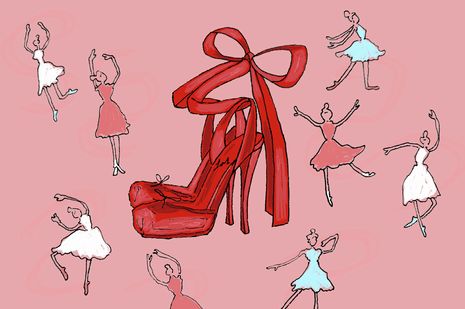An enquiry into the newest ballet shoe, the Cassia Lace Up
Irina Echim explores the history of the ballet flat, and how it became the ballet heel

On July 9th this year, Christian Louboutin made an apparently risky business choice (and a bold brand statement) by launching the Cassia Lace Up heels. Don’t know what they look like? If you want to visualise them, all you need to do is imagine a traditional pink pointe shoe – with a heel attached to it.
It is easy to infer that Louboutin’s new design is as much a response to recent consumer fervour surrounding the ballerina aesthetic that swept TikTok last year as it is a product of creative innovation. The famous ballerina flats came back in trend two years ago, and, soon enough, most reputable fashion houses created their own version of the shoe. Maison Margiela, Miu Miu and Ganni are just some of the names that immediately come to mind. But in this sea of different brands’ authentic takes on the ballet flat, there also existed another notable name: Repetto. Repetto was founded in 1947 on a street adjacent to the Paris Opera, and has produced ballerina flats almost exclusively since then. These ballerina flats are rumoured to be the epitome of quality and, in any case, the peak of quantity, since most Repetto stores feature ballet flats in all possible sizes and colours. You might remember this name by thinking of that one brand that continues to use – as if in a silent war with the industry’s obsession with Roboto – a really quirky, antique typewriter-style font.
“Consumer psychology is a rather goofy phenomenon: as buyers, we nurture a great love for anything familiar while still desiring novelty”
2024 was a year in which consumer interest in Repetto peaked, but the brand slowly exited the eye of the public in 2025. Part of this interest decrease is due to the ballet flats’ market oversaturation. One must remember, at the end of the day, that a new and shiny Frankenstein made its appearance in the apparel world this spring: the sneakerina (also known as a sneaker that bears similarities to a ballet flat). Brands like Adidas, Puma and even Nike intuited an emergent market gap and jumped at the opportunity to merge two apparently irreconcilable shoe archetypes: the coquette ballet flat and the sporty sneaker. The sneakerina sold like warm bread during this year’s spring and summer seasons. Consumer psychology is a rather goofy phenomenon: as buyers, we nurture a great love for anything familiar while still desiring novelty. An innovative take (the sneakerina) on a product that is already esteemed by purchasers of shoes is, therefore, a genius market move that drives profit.
Louboutin’s launch of the Cassia Lace Up is, as such, informed by both the former popularity of ballet flats and the commercial triumph of the sneakerina. At the same time, however, the Cassia Lace Up differs radically from the trends mentioned above: it is neither affordable, nor necessarily marketed towards the same customer base. Let us ponder one simple question: what is the stereotypical age profile of the average ballet flat buyer? The answer to this question is almost non-debatable: ballet flats, although bought by a panoply of people, have lately been marketed specifically for Gen Z. This is probably because the trends that led to the rise of the ballet flat were started and stimulated by Gen Z influencers that took part in the notorious clean girl, ballerina and pilates princess aesthetic movements. As well as ballet flats, a conventional Gen Z influencer’s profile will usually bombard audiences with other ballet accessories: leotards, sheer wrap-around skirts, visible ribs, sleek-buns.
“Despite the risk, the Cassia Lace Up sold out fairly quickly and, even more rapidly, Steve Madden launched its own replica of the shoe”
The corollary is that Louboutin’s latest product is directed at Gen Z-ers. Browsing the Louboutin online shopping site, one cannot help but notice the ludicrous discrepancy between the elegant, Louboutin-style pointed toes and the pink, cutesy (what word other than cutesy might one use to describe a ballerina heel?) pointe-style toe. In addition to Gen Z style being rather off-brand for Louboutin, manufacturing a product that epitomises the collective accessory preference of a generation that does not yet possess massive amounts of capital or economic agency is particularly perilous. Despite the risk, the Cassia Lace Up sold out fairly quickly and, even more rapidly, Steve Madden launched its own replica of the shoe.
There are two conclusions that one can arrive at, following our inquiry into the eventful recent history of the ballet flat and the thought process that motivated Louboutin’s latest launch. First of all, Gen Z (or, at least, a figment of Gen Z – perhaps that same figment that could have been classified as a hypebeast in 2016) is finally economically potent enough for high-end designers to consider their purchasing preferences in determining their creative direction. Secondly, in its launch of the pointe-style heel, Louboutin flagged a blunt and ostentatious move away from the brand’s devotion to making powerful shoes meant to be worn by powerful women. The pointed toe and luscious leather instil respect, perhaps even fear, in the eye of the beholder. A ballet-style bow, in contrast, portrays the wearer as cute, volatile, infantile, submissive.
While to some this might seem a drastic interpretation, Louboutin’s latest launch feels like another step in the fashion industry’s transition towards more patriarchal perspectives on the feminine.
 News / Cambridge study finds students learn better with notes than AI13 December 2025
News / Cambridge study finds students learn better with notes than AI13 December 2025 News / Uni Scout and Guide Club affirms trans inclusion 12 December 2025
News / Uni Scout and Guide Club affirms trans inclusion 12 December 2025 News / Cambridge Vet School gets lifeline year to stay accredited28 November 2025
News / Cambridge Vet School gets lifeline year to stay accredited28 November 2025 Comment / The magic of an eight-week term15 December 2025
Comment / The magic of an eight-week term15 December 2025 Film & TV / Making a case for reality TV13 December 2025
Film & TV / Making a case for reality TV13 December 2025










